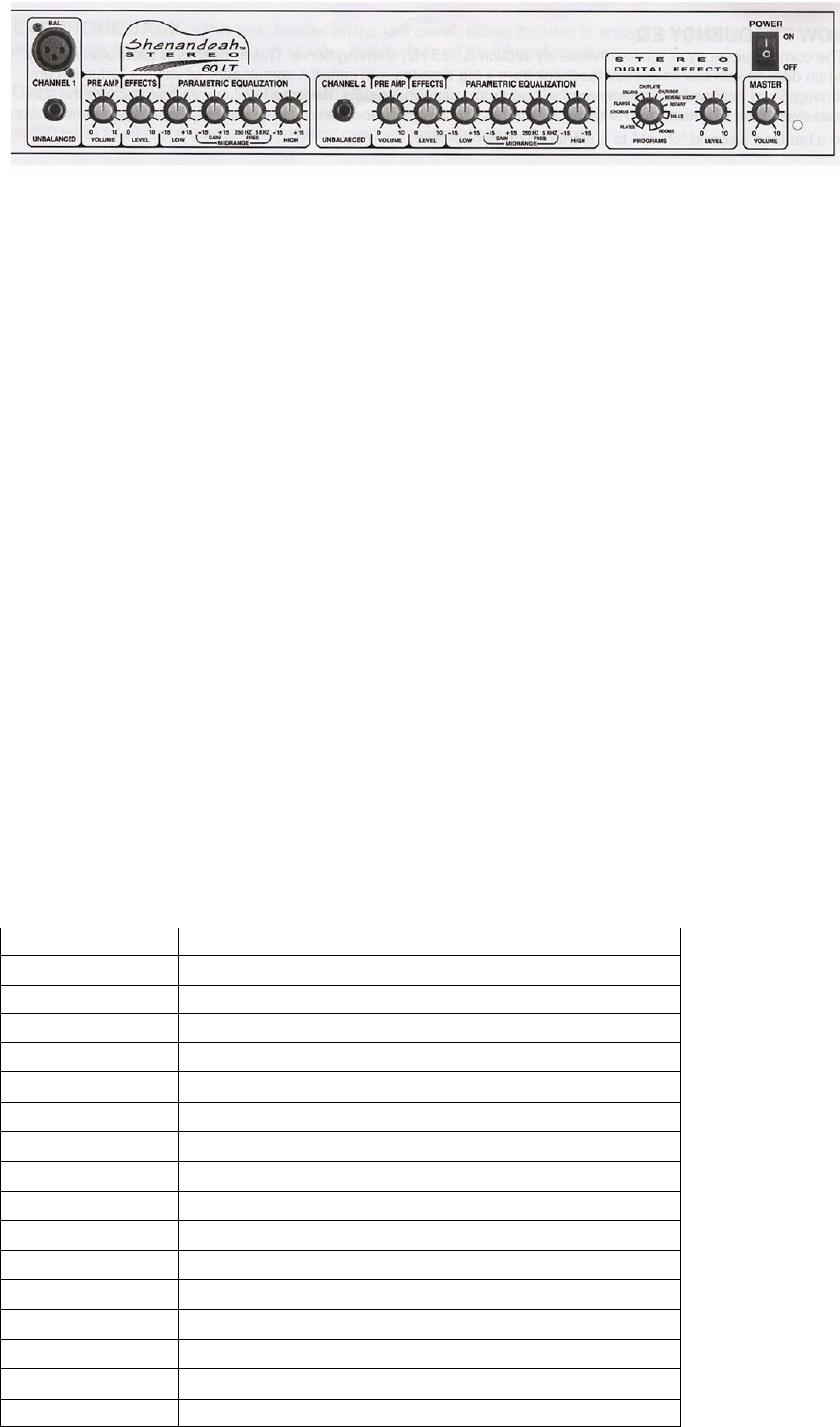
FRONT PANEL
INPUTS -The Shenandoah™ Stereo 60LT is equipped with two types of input jacks. The ¼” input is unbalanced and
“line/instrument level” with a useable sensitivity from 50 mV to 1.6 volt. The input impedance is 220 k ohms. The ¼”
input will also accept most active balanced line sources, automatically unbalancing them by recognizing the tip portion
of the balanced signal. If an instrument offers an unbalanced output it should be connected to the unbalanced input of
the Shenandoah amp. Additionally, the precision input scaling preamp contains a 45 Hz, 12 dB/octave high pass filter
(more effective and less intrusive than the more common 6 dB filters) and an “RFI” filter (radio frequency interference)
to eliminate unwanted noise. The XLR input jack is balanced and “microphone level”, with a useable sensitivity from –
60 dBv to -30 dBv. It is not a line level input. It contains a precision full range differential microphone preamp with
phantom power. For use with higher-level sources (such as the balanced line level output from a keyboard or other
instruments), a balanced pad network will be necessary to use the balanced input. For instance, a Rapco “Pad Blox”,-
20 or -30 pad or similar product could be used.
COMBINING XLR & ¼” INPUTS -A unique feature of the Shenandoah™ Stereo 60LT is the ability to mix the XLR
balanced and ¼” unbalanced inputs on channel 1. In many situations, this effectively makes the amplifier function as a
3 channel amplifier. The most effective way to use this feature is to set the volume on the channel using the XLR
microphone input and then adjust the level control on the instrument itself (assuming that it has one) to blend levels
between the 2 inputs.
ON-BOARD STUDIO QUALITY STEREO DIGITAL EFFECTS -The Shenandoah™ Stereo 60LT contains a 24-bit,
16 program stereo digital effects processor. We chose to use an industry leader in digital effects processing for
realistic, high quality effects algorithms. Level differences are normal when switching between different effects; just
adjust the channel send and master level controls accordingly. The effects level control on each channel adjusts the
send level to the digital effects processor. The digital effects level in the master section controls the effects return level
from the processor. Turning up the channel effects send will yield lusher effects response. Running the channel effects
send lower and the master level higher will yield softer effects response.
PROGRAM DESCRIPTION
Name Description
Hall 1 Bright hall reverb
Hall 2 Warm hall reverb
Room 1 Hardwood studio reverb
Room 2 Ambient room reverb
Room 3 Warm room reverb for guitars and rhythm instruments.
Plate 1 Classic plate reverb for lead vocals and instruments.
Plate 2 Sizzling bright plate reverb for vocals.
Plate 3 Short “vintage” plate reverb
Chorus Stereo chorus (Tonal variations in pitch and volume)
Flange Stereo flanger for jet wash effects.
Delay 1 125ms slapback delay
Delay 2 190ms slapback delay
Chorus/ Plate Chorus with reverb plate
Chorus/ Room Auto-wah guitar effect with reverb
Reverse Scoop Mid-range scoop tone
Pitch Shift Rotary Rotary speaker emulation









